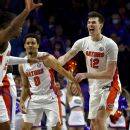Angry
Well-known member
- Joined
- Apr 8, 2012
- Messages
- 3,383
- Reaction score
- 1,623
- Points
- 113
Which men's college basketball teams lose the most minutes to players who transfer out?
Eighty-four percent of the minutes logged by the 2020-21 Minnesota Golden Gophers came from players who transferred out for the next season, including Both Gach (11), Gabe Kalscheur (22) and Marcus Carr (5). Harrison Barden-USA TODAY Sports6:20 AM CT
-

John GasawayESPN Insider
Welcome to the final installment in our series on college basketball's new era of frequent transfers.
First we considered the most significant modern-era transfers into and out of more than 80 of the nation's leading men's programs across the SEC, Pac-12, Big 12, AAC, Big East, Big Ten and ACC.
Then we quantified the impacts of granting an additional year of eligibility and of the NCAA's adoption of a one-time transfer rule for revenue sports. We found that last season transfers accounted for 40% of the minutes played at major-conference programs.
Today, we bring this discussion to a close with a look at out-transfers -- or players who transfer out. Is the trend toward more major-conference minutes for incoming transfers matched by a correspondingly high rate of departures? Which programs are losing and/or burning through the most talent?
The departing 18%
Players who have already transferred out of their respective major-conference programs just in the past season collectively recorded 18% of all the minutes for their original teams. Naturally, this number for the 2021-22 campaign's out-transfer rate will increase in the future, as more players who saw action last season elect at some point to make a change. If we look at the updated out-transfer rate for major-conference minutes played back in 2020-21, for example, that number has so far climbed to 29%.
Saying that the players who recorded 18% of all minutes transferred out doesn't mean the population responsible for the other 82% stayed put. A fair portion of that 82% was recorded by players who, even in this era of expanded limits, at last came to the end of their eligibility. Others went pro, either domestically or abroad. A few simply stopped playing, even with eligibility remaining.
14dAlex Scarborough
- Every out-transfer is, of course, some other program's in-transfer. In the NCAA as a whole, these roster debits and credits balance each other symmetrically.
As a result, the number of minutes that major-conference programs lose to out-transfers hasn't charted the same steep increase as in-transfer minutes in recent years. There are and will always be exceptions to this rule (keep reading), but for the most part, starters in the top conferences have less incentive to transfer out than many of their fellow Division I players.
Coaching changes and out-transfers
The most common incentive for transferring out regardless of conference membership is a coaching change. Ranking major-conference programs by out-transfer rate therefore results in a list that reads like a chronology of teams that have hired new coaches within the past five years.
Here are the highest percentages of minutes played by eventual out-transfers at major-conference programs, from the 2018-19 season to the 2021-22 season:
1. Pittsburgh: 56%
2. Oklahoma: 50%
3. Utah: 49%
4. Arizona State: 45%
Indiana: 45%
Missouri: 45%
Texas A&M: 45%
8. DePaul: 44%
9. Georgia: 42%
South Carolina: 42%
The figures shown here for out-transfers are up to the minute and include announcements made by newly minted out-transfers in the spring and summer of 2022. So, the very recent and substantial departures at programs such as Missouri and South Carolina are reflected in these totals.
So which individual team had the most minutes played by eventual out-transfers in a single season? The answer might surprise you, because, no, it was not LSU in 2021-22.
ESPN Daily podcast

Monday through Friday, host Pablo Torre brings you an inside look at the most interesting stories at ESPN, as told by the top reporters and insiders on the planet. Listen
While new coach Matt McMahon did indeed have literally zero players returning from last season at one particularly stressful moment at the start of his tenure with the Tigers, not every departure was due to a transfer. Tari Eason, Darius Days and Shareef O'Neal, for example, elected to pursue opportunities to play professionally.
McMahon's "zero" also became a three when Mwani Wilkinson, Justice Williams and Adam Miller all withdrew their names from the transfer portal and elected to stay in Baton Rouge. Add it all up and the Tigers gave 56% of their minutes last season to players who have since transferred. A high number, certainly, but not a record, not even in last season's SEC. (See Missouri: 68%.)
Here are the major-conference programs that listed the highest percentage of minutes played by eventual out-transfers in a single season from 2018-19 to 2021-22:
1. Minnesota (2020-21): 84%
2. Georgia (2020-21): 78%
3. Pitt (2018-19): 76%
Oklahoma (2020-21): 76%
5. Pitt (2019-20): 75%
6. Iowa State (2020-21): 73%
7. St. John's (2019-20): 68%
Missouri (2021-22): 68%
9. Texas Tech (2020-21): 66%
10. DePaul (2019-20): 65%
Indiana (2019-20): 65%
The Minnesota team of 2020-21 sent the equivalent of an entire eight-deep rotation out into the rest of men's college basketball. Leading scorer Marcus Carr transferred to Texas, and his example was followed by no fewer than seven teammates: Liam Robbins(Vanderbilt), Gabe Kalscheur (Iowa State), Brandon Johnson (DePaul), Jamal Mashburn Jr. (New Mexico), Both Gach (Utah), Tre' Williams (Oregon State) and Sam Freeman(Pacific, Division III).
Teams that have produced the highest numbers for out-transfer minutes over the past four seasons typically have just undergone a coaching change or are within a year of undergoing such a change. Minnesota parted ways with Richard Pitino in March 2021, the same month that Lon Kruger retired at Oklahoma. Georgia and Tom Crean called it a day this past March. Jeff Capel's first team at Pitt was the 2018-19 edition of the Panthers.
play
0:20
White drains tough layup
Arizona State's Remy Martin finds Romello White down low for the key layup to extend the Sun Devils lead.
When the coach stays and the player goes
Conversely, looking only at coaches who held the same positions for at least five seasons illustrates which programs export more transfers as a matter of course and not merely a regime change.
Here are the highest percentages of minutes played by eventual out-transfers at major-conference programs without a coaching change from 2018-19 to 2021-22:
1. Arizona State: 45%
2. West Virginia: 36%
3. Northwestern: 35%
4. Georgetown: 31%
5. TCU: 30%
6. Clemson: 26%
Rutgers: 26%
8. Colorado: 25%
9. Oregon: 24%
Washington: 24%
Romello White, Alonzo Verge Jr., Taeshon Cherry, Jaelen House, Holland Woods and, most prominently, Remy Martin all left Arizona State between 2019 and 2021 with eligibility remaining. White, Verge and Martin did so as regular starters.
Then last season, Jalen Graham and Jay Heathmade a combined 39 starts for the Sun Devils. They have since transferred to Arkansas and Georgetown, respectively.
For what it's worth, programs like Arizona State, TCU, Clemson and Oregon have stood out for being active at both ends of the transfer market -- incoming and outgoing -- even in the absence of any coaching changes. All four of these teams were also ranked in the top 10 for incoming transfer minutes.
In short, the pandemic-era rule changes pertaining to eligibility and transfers have transformed the manner in which major-conference programs collectively (though not at all universally) acquire new players. On the flip side of the portal, however, major-conference out-transfer rates might continue to correlate best with coaching changes and playing time, even as players are granted greater flexibility in their comings and goings.

